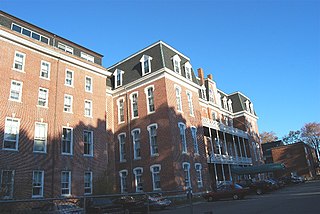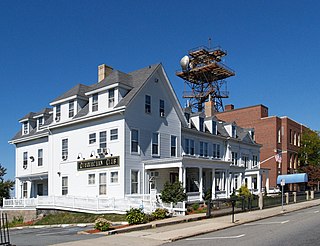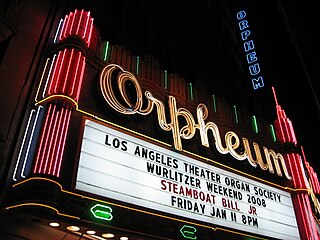
The University of Massachusetts Dartmouth is a public research university in Dartmouth, Massachusetts. It is the southernmost campus of the University of Massachusetts system. Formerly Southeastern Massachusetts University, it was merged into the University of Massachusetts system in 1991.

The architectural firm Rapp and Rapp was active in Chicago, Illinois during the early 20th century. Brothers Cornelius Ward Rapp (1861–1926) and George Leslie Rapp (1878–1941) of Carbondale, Illinois were the named partners and 1899 alumni of the University of Illinois School of Architecture.

Thomas White Lamb (1871–1942) was a Scottish-born, American architect. He is noted as one of the foremost designers of theaters and cinemas in the 20th century.
Orpheum is a name often used for theatres or other entertainment venues. It may refer to:

Gridley James Fox Bryant, often referred to as G. J. F. Bryant, was a Boston architect, builder, and industrial engineer whose designs "dominated the profession of architecture in [Boston] and New England." One of the most influential architects in New England, he designed custom-made houses, government buildings, churches, schoolhouses, and private residences across the United States, and was popular among the Boston elite. His most notable designs are foundational buildings on numerous campuses across the northeastern United States, including Tufts College, Bates College, and Harvard College. He has been credited as one of the first modern architects in America, and at the height of his career he was the most commissioned architect in New England. He is also the most commissioned architect in Boston history.
Ross and Macdonald was one of Canada's most notable architecture firms in the early 20th century. Based in Montreal, Quebec, the firm originally operated as a partnership between George Allen Ross and David MacFarlane from 1907 to 1912. MacFarlane withdrew from the firm in 1912, and Robert Henry Macdonald became a partner.

The Boston Music Hall was a concert hall located on Winter Street in Boston, Massachusetts, with an additional entrance on Hamilton Place.

St. Anne's Church and Parish Complex, now St. Anne's Shrine, is a national historic landmark located at the intersection of South Main and Middle streets in Fall River, Massachusetts. Until 2018, it was a parish in the Roman Catholic Diocese of Fall River. In addition to the church, the complex also includes the former Dominican Order monastery as well as the former Dominican Academy, constructed in 1894. The great upper church was formally dedicated on July 4, 1906 and closed November 25, 2018. The Lower Crypt Church shrine was re-opened July 4, 2019, but the upper part of the church remains closed for restoration and renovation.

The Jesus Mary Convent is a historic former convent located at 138 St. Joseph's Street in Fall River, Massachusetts. It was built in 1887 and designed by local architect and parish member Louis G. Destremps, who also designed the nearby orphanage, school and church.

George Albert Clough was an architect working in Boston in the late 19th-century. He designed the Suffolk County Courthouse in Pemberton Square, and numerous other buildings in the city and around New England. Clough served as the first City Architect of Boston from 1876 to 1883.

The Mississippi Lofts and Adler Theatre is an apartment building and theater complex located in downtown Davenport, Iowa, United States. It is individually listed on the National Register of Historic Places by its original name, the Hotel Mississippi-RKO Orpheum Theater. The Hotel Mississippi was listed on the Davenport Register of Historic Properties in 2005. In 2020 the complex was included as a contributing property in the Davenport Downtown Commercial Historic District.

St. Anthony of Padua is a Roman Catholic church in New Bedford, Massachusetts, part of the Diocese of Fall River.

Louis G. Destremps (1851–1930) was a Canadian-born American architect who worked extensively with the Roman Catholic Church and other clients in Fall River, Massachusetts. He is the father of Louis E. Destremps, who also designed notable buildings in the New Bedford, Massachusetts area.

Notre Dame de Lourdes, known from 2012 to 2018 as St. Bernadette Parish, is a former Roman Catholic parish in Fall River, Massachusetts. A part of the Roman Catholic Diocese of Fall River, the parish was established in 1874 to serve the growing French-Canadian population located in the city's Flint Village section. Since its founding, the parish has occupied three different church buildings; a wooden structure (1874–1893), a spectacular granite church (1906–1982) and the current modern church (1986-2018). The parish complex over time has also consisted of other multiple buildings, including St. Joseph's Orphanage, The Jesus Marie Convent, a school, the church rectory, the Brothers' residence, and the former Msgr. Prevost High School. The parish also includes Notre Dame Cemetery, located in the city's south end.

The Orpheum Theater is an old theatre and movie house located at 1005 Water Street in New Bedford, Massachusetts USA, originally named the Majestic Opera House.

Nathaniel Cannon Smith (1866–1943), professionally known as Nat. C. Smith, was an American painter and architect of New Bedford, Massachusetts.

The Orpheum Circuit was a chain of vaudeville and movie theaters. It was founded in 1886, and operated through 1927 when it was merged into the Keith-Albee-Orpheum corporation, ultimately becoming part of the Radio-Keith-Orpheum (RKO) corporation.

Robert Brown Young was a Canadian-born architect who designed buildings in California.
Nathan Corwith Wyeth was an American architect. He is best known for designing the West Wing of the White House, creating the first Oval Office. He designed a large number of structures in Washington, D.C., including the Francis Scott Key Bridge over the Potomac River, the USS Maine Mast Memorial, the D.C. Armory, the Tidal Basin Inlet Bridge, many structures that comprise Judiciary Square, and numerous private homes—many of which now serve as embassies. He also co-designed the Cannon House Office Building, the Russell Senate Office Building, the Longworth House Office Building, and an addition to the Russell Senate Office Building.

J. Williams Beal, Sons, successor to the office of J. Williams Beal, was a successful architectural firm based in Boston, Massachusetts. Established in 1920 by the sons of the late architect Beal, it remained in business into the 1980s.



















